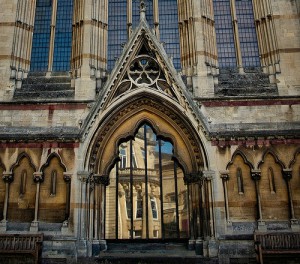Shaping Theme in Acts: Resurrection
 As we study the book of Acts, there are certain themes which rise to the surface that are really important to consider. We are not laying Acts out in front of us like a set of blueprints, sitting down and figuring out seven steps to get a thriving, vibrant church where all the younger generation is engaged and taking leadership roles and all the non-Christians around us are being saved. That’s not how God works. He doesn’t give us those lists that we like – seven steps for this, eight steps for that. God works like a clay modeler, shaping and molding us through his Word. We are not the architect of the church, we are the building; we are not the sculptor of the church, we are the clay. God will shape us the way he wants us to be if we’ll do our part and be pliable.
As we study the book of Acts, there are certain themes which rise to the surface that are really important to consider. We are not laying Acts out in front of us like a set of blueprints, sitting down and figuring out seven steps to get a thriving, vibrant church where all the younger generation is engaged and taking leadership roles and all the non-Christians around us are being saved. That’s not how God works. He doesn’t give us those lists that we like – seven steps for this, eight steps for that. God works like a clay modeler, shaping and molding us through his Word. We are not the architect of the church, we are the building; we are not the sculptor of the church, we are the clay. God will shape us the way he wants us to be if we’ll do our part and be pliable.
The first theme in Acts is resurrection. Jesus’ resurrection is our backbone as believers, as Christians and as a church. If we forget and move beyond his resurrection, we’ll become religious jellyfish without any backbone – just squishy with vague, religious beliefs, but no firm, orienting convictions. The resurrection is essential for us if we are going to be Christians together, so we will start here.
Think about how unlikely it is that the church even still exists. We’re so frail and fallible, messing up so often. Prominent church leaders fall from grace; we split; we bicker; how does this still continue 2,000 years after Jesus? Why are we here? Why is the church still working? How did it start? The believers we read about joined up with this even though they could have possibly been killed. Why? In Acts, we see the reason why these people did it: they saw Jesus alive after they saw him killed.
Jesus’ Resurrection: The Core of the Church
Here are five considerations about Jesus’ resurrection:
- The eye-witness accounts of Jesus’ resurrection were put to paper early after his death (within 10-15 years). The eye witness accounts were not some myth made up way later when no one could have verified it – they were written down and spread around while these people were still alive (1 Corinthians 15:6).
- The accounts of Jesus’ resurrection and appearances were problematic, especially because the first people to see Jesus were women (in that culture, women’s testimonies had no weight or value whatsoever). If these were just clever con-men trying to devise a fake religion, they would never have started like this.
- The witness testimonies about Jesus’ resurrection are twofold: the tomb was empty and people saw Jesus alive. If it had only been one or the other, there would have been holes in the story. If people had said “the tomb is empty,” others could have thought the disciples had somehow stolen the body. If people had said “we saw Jesus,” others could have just looked in the tomb and seen the body there and known they were lying. Because it was both, no one could refute it.
- These people were not primitive, ape-like morons. They weren’t dumb and neither Jews nor non-Jews would have easily believed in an individual resurrection. It would have taken a lot of convincing. For all these people to suddenly believe in Jesus’ resurrection, they must have seen some pretty convincing evidence.
- Whether you believe in Jesus’ resurrection or not, something clearly happened that made the church explode onto the scene against all odds. Something happened that initiated the church.
 One historian says it is historically secure to say that Jesus Christ arose from the dead. Jesus’ resurrection was the spark that lit the fire of the church, and it continues to this day against all odds. The first disciples weren’t philosophers, gurus, or brilliant men, they were witnesses (Acts 1:8) – people who help establish facts objectively through verifiable observation. Their method for evangelism was going around saying, “Look at what we’ve heard and what we’ve seen!” The resurrection was the backbone to the early church, and it was central to their message.
One historian says it is historically secure to say that Jesus Christ arose from the dead. Jesus’ resurrection was the spark that lit the fire of the church, and it continues to this day against all odds. The first disciples weren’t philosophers, gurus, or brilliant men, they were witnesses (Acts 1:8) – people who help establish facts objectively through verifiable observation. Their method for evangelism was going around saying, “Look at what we’ve heard and what we’ve seen!” The resurrection was the backbone to the early church, and it was central to their message.
Christianity is not about a philosophy or a set of practices, but a person who lived in history, was killed and rose from the dead. To be Christians together, we have to start here with a new confirmation of our faith in Jesus Christ, our risen Savior and our risen Lord. We can strip away everything and this is the core: Jesus Christ. He lived perfectly, died on the cross in payment for our sins, three days later he arose from the grave, confirming it all, and now is ascended and is at the hand of the Father interceding for us – do you believe it, or do you not believe it? Without this shared conviction together, no amount of strategizing, no amount of elbow grease, no amount of creative marketing technique, no amount of programming will build the church. This is the only shared faith that can unite us, identify us, found us, form us: faith in the risen Jesus Christ.
To You (Whoever You Are): Jesus Lives
To those missing from fellowship: Jesus lives, and he wants his followers to be following him together; that’s how he designed it to work. So ultimately, rejection of fellowship and the church is rejection of the living Jesus Christ himself. Whether it’s here, there, or anywhere, Christians need to be in the fellowship of church because Jesus commands it.
To those dealing with the compounding complications of aging: Jesus lives; so no matter the hardships that come, we always have reason for hope. He defeated death itself, and death, therefore, has no sting for us.
To the hardening – those who are tempted to embrace ongoing, unrepentant sin in their lives: Jesus lives, and there is really only one choice. Repent, receive forgiveness through Jesus Christ and freedom from those sins, and be welcomed into the fellowship of God’s people, or reject Jesus Christ.
To the church – to us all: Jesus lives, and his resurrection is our backbone. Let us be shaped by a shared belief in the resurrection of Jesus Christ, our Savior and Lord. He’s alive!
From the sermon series: Shaping Themes in Acts.






